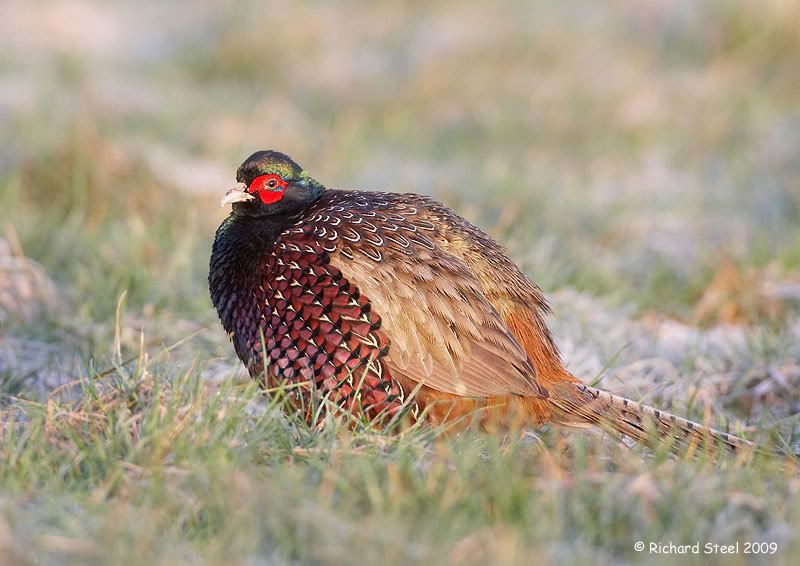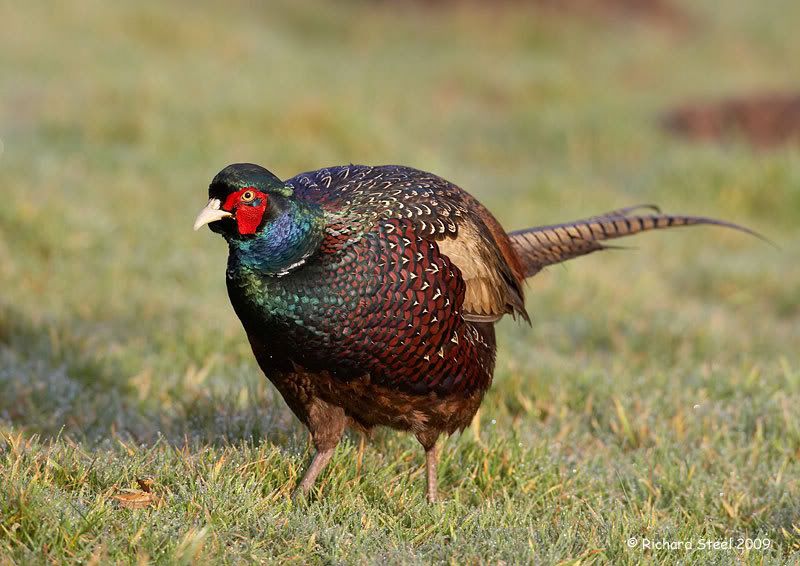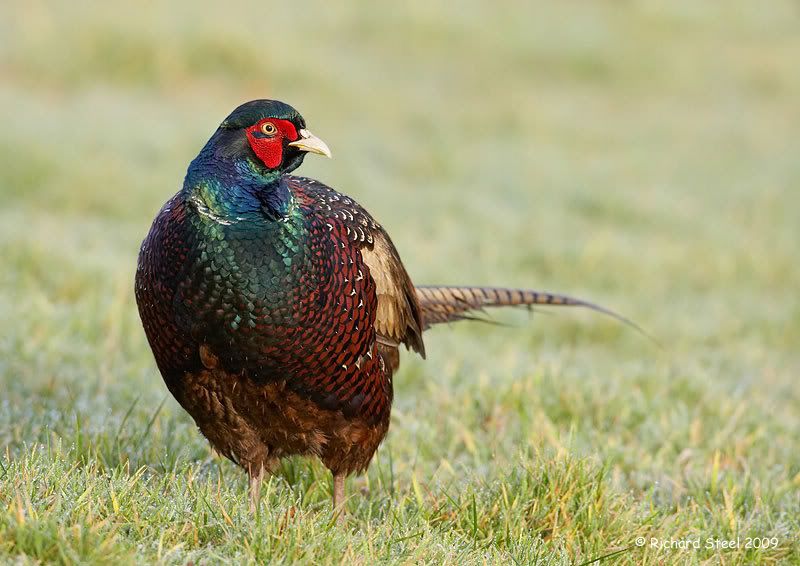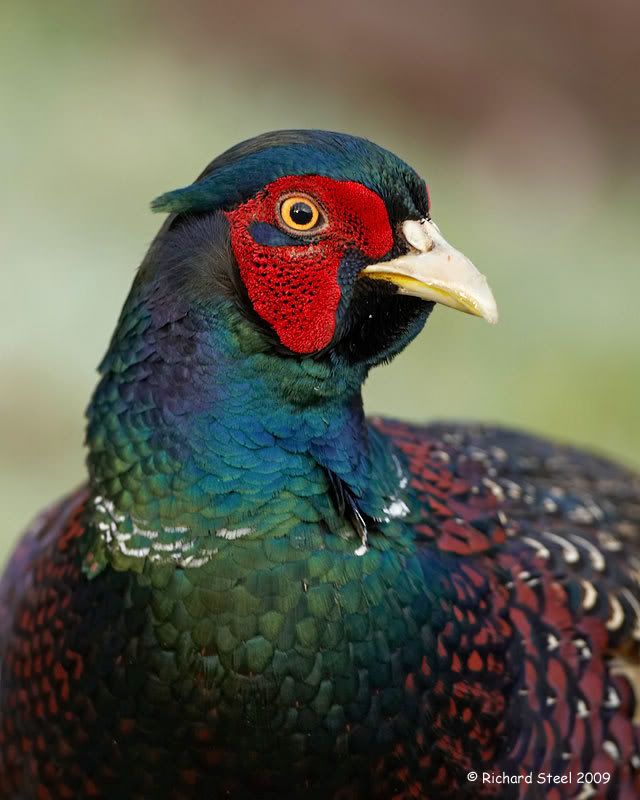Pheasant Surprise
Firstly regular viewers will notice that I have decided to change the size of the Blog. I hope this works OK and if anyone has any problems viewing then please let me know. The main reason for doing this is so I can display bigger images.
While waiting for some brown hares to appear the other day, I had the opportunity to photograph a couple of pheasants. They are such beautifully coloured birds that I can rarely resist when they appear in front of the lens. However, they are quite difficult birds to compose well within the frame due to their long tail. This often means you need to be a long distance to fit the bird in which leads to loss of detail.
and a head shot to finish
Saturday, February 28, 2009
Thursday, February 26, 2009
Snow Hares
 I thought there is always tomorrow but by the next day all the snow had virtually melted away. I felt as if I had missed an opportunity but with the happy consolation that it always good to get those first hare photos of the year :)
I thought there is always tomorrow but by the next day all the snow had virtually melted away. I felt as if I had missed an opportunity but with the happy consolation that it always good to get those first hare photos of the year :)
We had some snow recently, a seemingly rare winter event these days. Unfortunately living by the coast any snow which does appear usually quickly melts. As the snow lay around I was pondering on what I could try and photograph as it can create some great light. Hares running through snow seemed like a nice idea. Unfortunately I was late getting to the site and met with a carpet of snow covered in hare tracks. Looked like I had potentially missed some good action. During my search for the hares I only managed to find two, neither of which were running through snow!
The first was laying down and creating its own personal snow drift.
 The other stood staring for a while at close range before departing into some undergrowth.
The other stood staring for a while at close range before departing into some undergrowth.
 I thought there is always tomorrow but by the next day all the snow had virtually melted away. I felt as if I had missed an opportunity but with the happy consolation that it always good to get those first hare photos of the year :)
I thought there is always tomorrow but by the next day all the snow had virtually melted away. I felt as if I had missed an opportunity but with the happy consolation that it always good to get those first hare photos of the year :)
Sunday, February 22, 2009
Late Winter Thrushes


 At this particular site the redwing are a much more difficult bird to approach but as usual a bit of perseverance and patience pays off.
At this particular site the redwing are a much more difficult bird to approach but as usual a bit of perseverance and patience pays off. 
 Having got some photographs of the winter migrant thrushes I turned my attention to the residents. A mistle thrush was guarding a bush with its berries and chasing away other birds from its 'larder'. On look out from its bush
Having got some photographs of the winter migrant thrushes I turned my attention to the residents. A mistle thrush was guarding a bush with its berries and chasing away other birds from its 'larder'. On look out from its bush Dropping to the ground to mop up the berries of the birds it had chased off.
Dropping to the ground to mop up the berries of the birds it had chased off. Before returning to guard duty
Before returning to guard duty  The opportunity arose also to photograph song thrush, it was turning in to a good morning with all the main UK thrush species (I am thinking of those with spotted breast feathers) being photographed.
The opportunity arose also to photograph song thrush, it was turning in to a good morning with all the main UK thrush species (I am thinking of those with spotted breast feathers) being photographed.
 The bird then hopped over to the only shadow nearby that was cast by a thin post, aligned itself to the shadow and pointing away from me, and then smashed the snail and devoured the contents. I think I might have to wait a while to get the snail smashing photos, but I am sure one day it will happen.
The bird then hopped over to the only shadow nearby that was cast by a thin post, aligned itself to the shadow and pointing away from me, and then smashed the snail and devoured the contents. I think I might have to wait a while to get the snail smashing photos, but I am sure one day it will happen.
My photography opportunities have been very restricted over the last few weeks for two main reasons. Firstly the moments of good light have been few and far between as a grey gloom has descended over my local area. However, more importantly I have spent a good proportion of the time in intensive care at the side of my partner Dawn who suffered major complications after surgery. I am happy to say she came back home on Friday, but has a slow recovery ahead. Many thanks to all the people for their support through a stressful time.
I went out for a morning session on 7th February, between hospital visits, to both 'celebrate' my birthday and also take advantage of a rare opportunity for some good light. I decided to go and target some thrush species, particularly fieldfare and redwing, as they will be leaving soon and will not be around until next winter. As I have recently been taking many fieldfare photographs with the birds hopping around of grass looking for worms, I made a conscious effort to try and get the birds in some different settings. Only the first two photos of fieldfare were taken on the day, but I thought I would add the other two from a previous visit as it will be many months before I will make another post of this species



 At this particular site the redwing are a much more difficult bird to approach but as usual a bit of perseverance and patience pays off.
At this particular site the redwing are a much more difficult bird to approach but as usual a bit of perseverance and patience pays off. 
 Having got some photographs of the winter migrant thrushes I turned my attention to the residents. A mistle thrush was guarding a bush with its berries and chasing away other birds from its 'larder'. On look out from its bush
Having got some photographs of the winter migrant thrushes I turned my attention to the residents. A mistle thrush was guarding a bush with its berries and chasing away other birds from its 'larder'. On look out from its bush Dropping to the ground to mop up the berries of the birds it had chased off.
Dropping to the ground to mop up the berries of the birds it had chased off. Before returning to guard duty
Before returning to guard duty  The opportunity arose also to photograph song thrush, it was turning in to a good morning with all the main UK thrush species (I am thinking of those with spotted breast feathers) being photographed.
The opportunity arose also to photograph song thrush, it was turning in to a good morning with all the main UK thrush species (I am thinking of those with spotted breast feathers) being photographed.This is not a typical composition, but I liked the shadow, and so placed the bird to the right of the frame.  Listening for worms
Listening for worms One bird appeared from below a bush with a snail. I have always photograph a song thrush in typical snail smashing behaviour.
One bird appeared from below a bush with a snail. I have always photograph a song thrush in typical snail smashing behaviour. 
It dropped the snail and then picked it back up.  Listening for worms
Listening for worms One bird appeared from below a bush with a snail. I have always photograph a song thrush in typical snail smashing behaviour.
One bird appeared from below a bush with a snail. I have always photograph a song thrush in typical snail smashing behaviour. 
 The bird then hopped over to the only shadow nearby that was cast by a thin post, aligned itself to the shadow and pointing away from me, and then smashed the snail and devoured the contents. I think I might have to wait a while to get the snail smashing photos, but I am sure one day it will happen.
The bird then hopped over to the only shadow nearby that was cast by a thin post, aligned itself to the shadow and pointing away from me, and then smashed the snail and devoured the contents. I think I might have to wait a while to get the snail smashing photos, but I am sure one day it will happen.Wednesday, February 18, 2009
Last Waxwings

 Lucky photograph of the brief session was to catch one of the birds hovering off the end of some berries, having just plucked one while in flight.
Lucky photograph of the brief session was to catch one of the birds hovering off the end of some berries, having just plucked one while in flight.
There was recently a small flock of thirteen waxwings quite local to home for a couple of weeks in North Wales . They had become a popular attraction and even made front page of the local press. So I called in one late afternoon, to find the birds occasionally flying down to the rowan tree, being viewed by a small crowd and in some some wonderful low sunlight. I expect this will be my last session with the waxwings which no doubt will be departing northward soon. It has been a great winter for them across the UK and they are always a pleasure to photograph. For those interested the following photos were taken with the Canon 50D body. 


 Lucky photograph of the brief session was to catch one of the birds hovering off the end of some berries, having just plucked one while in flight.
Lucky photograph of the brief session was to catch one of the birds hovering off the end of some berries, having just plucked one while in flight.
Labels:
Waxwing
Sunday, February 15, 2009
Trip to the Zoo
 They are very beautiful cats and I find the new enclosure good for photography.
They are very beautiful cats and I find the new enclosure good for photography. Playful elephants
Playful elephants Komodo dragon taking a drink
Komodo dragon taking a drink Moving on to some close relations of the reptiles, with some of the zoo's birds. One of their large collection of conure species
Moving on to some close relations of the reptiles, with some of the zoo's birds. One of their large collection of conure species Crowned crane forming an almost abstract photo
Crowned crane forming an almost abstract photo Hornbill
Hornbill Pelican
Pelican I can only wish that the flock of pigeons that visit my back garden were this colourful!
I can only wish that the flock of pigeons that visit my back garden were this colourful!

I decided to take a trip to my local zoo at Chester as it always good to put a bit of exotic wildlife in front of the lens. It was very busy as you would expect at a weekend and I didn't stay too long, and just had a quick tour with the camera and 300mm lens. I like to take an occasional trip to the zoo as it requires a very different photographic technique to achieve good images and overcome the problems presented by mesh and glass enclosures. I was immediately drawn by the deep roaring of the male asiatic lion.
Then over to the new cheetahs, this one not looking to impressed about being photographed.

 Playful elephants
Playful elephants Komodo dragon taking a drink
Komodo dragon taking a drink Moving on to some close relations of the reptiles, with some of the zoo's birds. One of their large collection of conure species
Moving on to some close relations of the reptiles, with some of the zoo's birds. One of their large collection of conure species Crowned crane forming an almost abstract photo
Crowned crane forming an almost abstract photo Hornbill
Hornbill Pelican
Pelican I can only wish that the flock of pigeons that visit my back garden were this colourful!
I can only wish that the flock of pigeons that visit my back garden were this colourful!
Tuesday, February 10, 2009
Sawbills
 They are always quite scruffy looking birds with their wayward head feathers but the male was looking particularly smart on this occasion with prime condition plumage. The black head that changes to green as the head moves is difficult to expose properly with the camera especially when combined with the white feathers.
They are always quite scruffy looking birds with their wayward head feathers but the male was looking particularly smart on this occasion with prime condition plumage. The black head that changes to green as the head moves is difficult to expose properly with the camera especially when combined with the white feathers. Moving on too goosanders, which are a new species for me to photograph. I took a trip over to North Wales specifically to photograph these birds. It is always such a joy when you head out for a particular species, especially a new one, and come home with some results.
Moving on too goosanders, which are a new species for me to photograph. I took a trip over to North Wales specifically to photograph these birds. It is always such a joy when you head out for a particular species, especially a new one, and come home with some results.


 The males are a stunning bird but again a very tricky exposure.
The males are a stunning bird but again a very tricky exposure.



Sawbills are such wonderful looking birds and a great site as they feed in a team working their way up a lake. We have three species in the UK, the goosander, the red-breasted merganser and the smew. All are very attractive birds to photograph. Smew are generally very thin on the ground especially in my local area and in fact the only ones I have seen have been captive birds in waterfowl collections. The other two birds are notoriously tricky to get close. There are a few red-breasted merganser on the local marine lake each winter which is not an easy place to photograph them as it is a relatively large lake and they are happy to sit out in the middle way beyond camera range. Occasionally you get lucky.
Two females surface after a dive

 They are always quite scruffy looking birds with their wayward head feathers but the male was looking particularly smart on this occasion with prime condition plumage. The black head that changes to green as the head moves is difficult to expose properly with the camera especially when combined with the white feathers.
They are always quite scruffy looking birds with their wayward head feathers but the male was looking particularly smart on this occasion with prime condition plumage. The black head that changes to green as the head moves is difficult to expose properly with the camera especially when combined with the white feathers. Moving on too goosanders, which are a new species for me to photograph. I took a trip over to North Wales specifically to photograph these birds. It is always such a joy when you head out for a particular species, especially a new one, and come home with some results.
Moving on too goosanders, which are a new species for me to photograph. I took a trip over to North Wales specifically to photograph these birds. It is always such a joy when you head out for a particular species, especially a new one, and come home with some results.The rust red head of a female goosander


 The males are a stunning bird but again a very tricky exposure.
The males are a stunning bird but again a very tricky exposure.

and that characteristic male posture display with beak pointing skyward.

Wednesday, February 04, 2009
Assorted Waders
Knot Dunlin
Dunlin Redshank
Redshank Sanderling
Sanderling When they do wake and soft winter light is shining, with a bit of good positioning and luck you can then really enjoy the pleasure of photographing these wonderful birds
When they do wake and soft winter light is shining, with a bit of good positioning and luck you can then really enjoy the pleasure of photographing these wonderful birds
Small and fast across the water, a sanderling in flight.
 Purple Sandpiper
Purple Sandpiper  Knot feeding on the estuary mud.
Knot feeding on the estuary mud.  Wading redshank
Wading redshank
 and a bonus Black-tail Godwit while waiting for another species
and a bonus Black-tail Godwit while waiting for another species 
One of the reasons I love the winter is the assortment of waders that can be photographed locally. A group of birds I will never tire of photographing. The best tactic always seems to be to find a spot, keep low and still and wait for them to come to you, usually with the advancing tide. However, you can guarantee that just when they have come into photography range, you will see a dog running past in front of your lens and the flock taking flight. Chasing around a beach after waders is pointless as all you will end up with is photos of flying tail feathers. It is also important that the birds are allowed to feed and roost undisturbed to conserve their energy on those windswept winter beaches. The prime consideration of any wildlife photographer should always be for the welfare of their subject. So let sleeping waders sleep...
Knot
 Dunlin
Dunlin Redshank
Redshank Sanderling
Sanderling When they do wake and soft winter light is shining, with a bit of good positioning and luck you can then really enjoy the pleasure of photographing these wonderful birds
When they do wake and soft winter light is shining, with a bit of good positioning and luck you can then really enjoy the pleasure of photographing these wonderful birdsSmall and fast across the water, a sanderling in flight.
 Purple Sandpiper
Purple Sandpiper  Knot feeding on the estuary mud.
Knot feeding on the estuary mud.  Wading redshank
Wading redshank
Oystercatcher looking for earthworms
 and a bonus Black-tail Godwit while waiting for another species
and a bonus Black-tail Godwit while waiting for another species 
Subscribe to:
Posts (Atom)
















